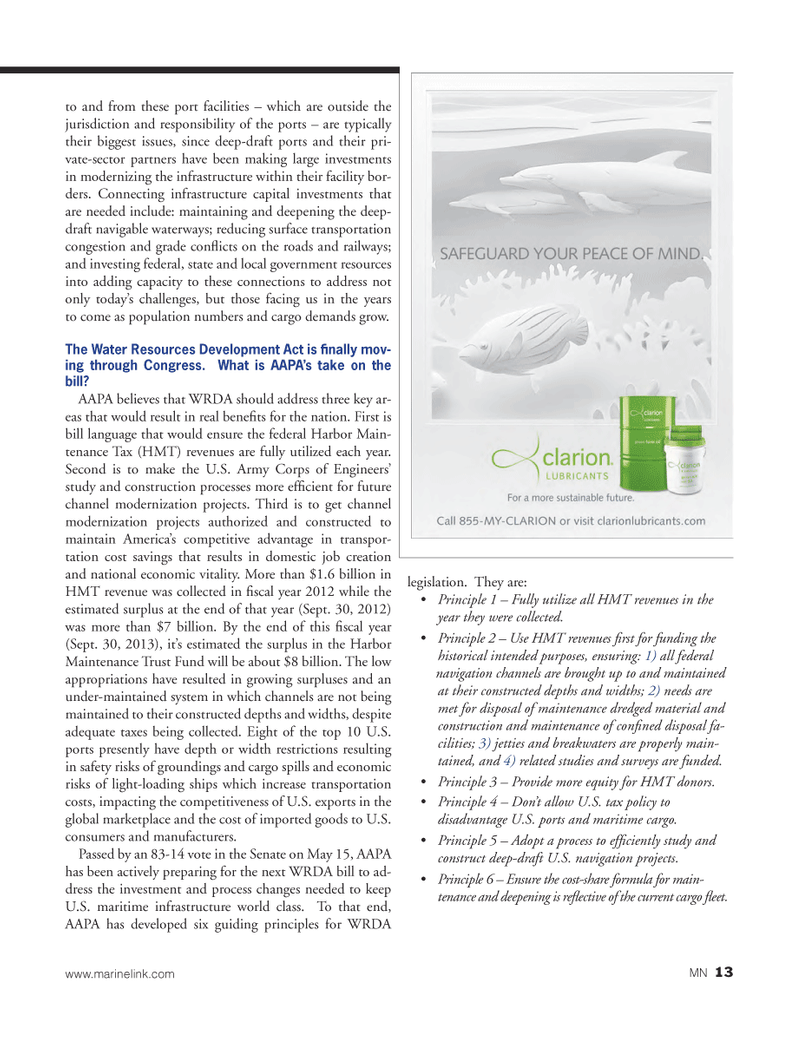
Page 13: of Marine News Magazine (June 2013)
Dredging & Marine Construction
Read this page in Pdf, Flash or Html5 edition of June 2013 Marine News Magazine
to and from these port facilities ? which are outside the jurisdiction and responsibility of the ports ? are typically their biggest issues, since deep-draft ports and their pri- vate-sector partners have been making large investments in modernizing the infrastructure within their facility bor- ders. Connecting infrastructure capital investments that are needed include: maintaining and deepening the deep- draft navigable waterways; reducing surface transportation congestion and grade con icts on the roads and railways; and investing federal, state and local government resources into adding capacity to these connections to address not only today?s challenges, but those facing us in the years to come as population numbers and cargo demands grow. The Water Resources Development Act is Þ nally mov- ing through Congress. What is AAPAÕs take on the bill? AAPA believes that WRDA should address three key ar- eas that would result in real bene ts for the nation. First is bill language that would ensure the federal Harbor Main- tenance Tax (HMT) revenues are fully utilized each year. Second is to make the U.S. Army Corps of Engineers? study and construction processes more ef cient for future channel modernization projects. Third is to get channel modernization projects authorized and constructed to maintain America?s competitive advantage in transpor- tation cost savings that results in domestic job creation and national economic vitality. More than $1.6 billion in HMT revenue was collected in scal year 2012 while the estimated surplus at the end of that year (Sept. 30, 2012) was more than $7 billion. By the end of this scal year (Sept. 30, 2013), it?s estimated the surplus in the Harbor Maintenance Trust Fund will be about $8 billion. The low appropriations have resulted in growing surpluses and an under-maintained system in which channels are not being maintained to their constructed depths and widths, despite adequate taxes being collected. Eight of the top 10 U.S. ports presently have depth or width restrictions resulting in safety risks of groundings and cargo spills and economic risks of light-loading ships which increase transportation costs, impacting the competitiveness of U.S. exports in the global marketplace and the cost of imported goods to U.S. consumers and manufacturers. Passed by an 83-14 vote in the Senate on May 15, AAPA has been actively preparing for the next WRDA bill to ad- dress the investment and process changes needed to keep U.S. maritime infrastructure world class. To that end, AAPA has developed six guiding principles for WRDA legislation. They are: Principle 1 ? Fully utilize all HMT revenues in the year they were collected. Principle 2 ? Use HMT revenues rst for funding the historical intended purposes, ensuring: 1) all federal navigation channels are brought up to and maintained at their constructed depths and widths; 2) needs are met for disposal of maintenance dredged material and construction and maintenance of con ned disposal fa- cilities; 3) jetties and breakwaters are properly main- tained, and 4) related studies and surveys are funded. Principle 3 ? Provide more equity for HMT donors. Principle 4 ? Don?t allow U.S. tax policy to disadvantage U.S. ports and maritime cargo. Principle 5 ? Adopt a process to ef ciently study and construct deep-draft U.S. navigation projects. Principle 6 ? Ensure the cost-share formula for main- tenance and deepening is re ective of the current cargo eet. MN 13www.marinelink.com MN June2013 Layout 1-17.indd 13MN June2013 Layout 1-17.indd 135/30/2013 11:54:23 AM5/30/2013 11:54:23 AM

 12
12

 14
14
